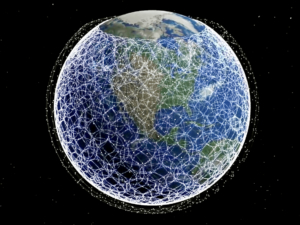Starlink is a global ISP built at ZERO COST to SpaceX, enabling NASA’s Artemis launch
 There is lots of good news lately for SpaceX, especially NASA choosing the Hawthorne, CA-based company to build a $2.89 billion lunar lander for NASA's Artemis Moon landing slated for 2024. Key to that single-source contract, which eliminates two competitors including Jeff Bezos' Blue Origin, was SpaceX's willingness to restructure payments to fit the $750 million appropriated by Congress this fiscal year for the project. Already the lowest Artemis bidder, Elon Musk's company was willing to make the deal work for the customer, which is unusual thinking for space contractors, with many asking, Where did SpaceX get the money?
There is lots of good news lately for SpaceX, especially NASA choosing the Hawthorne, CA-based company to build a $2.89 billion lunar lander for NASA's Artemis Moon landing slated for 2024. Key to that single-source contract, which eliminates two competitors including Jeff Bezos' Blue Origin, was SpaceX's willingness to restructure payments to fit the $750 million appropriated by Congress this fiscal year for the project. Already the lowest Artemis bidder, Elon Musk's company was willing to make the deal work for the customer, which is unusual thinking for space contractors, with many asking, Where did SpaceX get the money?
They got the money from your phone bill.
This Artemis win for SpaceX is just part of a bigger story that's emerging about a company that is steadily crushing its competitors by building a hyper-efficient space ecosystem where the other guys are just building rockets.
SpaceX's Starlink has already won the global ISP war. You are forgiven if you didn't know that and forgiven, too, if you didn't even know there was such a war. But there is one, and Starlink has already won it at a net cost of ZERO dollars. In fact, SpaceX, which owns Starlink, has won at a negative cost, which means they are making a profit building what for any other company would have been a cost measured in billions of dollars - dollars that can now be diverted to projects like financing NASA's Artemis lunar program.

Teledesic constellation
The dream that is Starlink began 31 years ago and was called Teledesic. It was the idea of mobile phone tycoon Craig McCaw and backed by a gang of heavyweights including Bill Gates. Teledesic was going to offer low earth orbit satellite Internet service anywhere the sky was visible with up to 720 megabits-per-second (mbps) down and 100 mbps up (both later cut to 10 mbps using fewer satellites). Clearly Teledesic never happened despite more than a decade of planning, hundreds of millions of dollars spent, and onesatellite launched. McCaw's idea was great but it simply cost too much at the time compared to ground infrastructure based on optical fibers and copper. The few potential Internet users who were too far away from their telco central office or cable head-end would just have to make-do with crappy geosynchronous satellite Internet or no Internet at all.

Starlink constellation
Fast-forward 25 years and the technical challenge that was Teledesic had changed quite a bit. Moore's Law had of course dramatically dropped the cost of schlepping the actual bits while Elon Musk's SpaceX had done a very good job of decreasing the cost of getting satellites into orbit. A Falcon 9 launch was still around $100 million, but satellites were much smaller and it was now possible to put many in space on the same rocket. Where Teledesic was projected to cost $9 billion in 2002 ($13.1 billion in 2021 dollars), SpaceX seems to be putting better-than-Teledesic Internet in the sky for zero net cost overall.
Part of this idea was covered in a column I wrote three years ago, explaining how SpaceX would all but put the other big launch companies like ULA and Arianespace out of business were it not for government subsidies. It's a good thing, then, that Blue Origin has Jeff Bezos's seemingly bottomless pockets.
Part of the reason Starlink is so cheap for SpaceX to do is because the company is vertically integrated. They design and build the satellites in Redmond, Washington that are then launched on SpaceX-manufactured rockets built in Hawthorne, California - rockets that have proven to be largely reusable, giving SpaceX by far the lowest cost per kilogram delivered to orbit.
Having thousands of Starlink satellites to launch means that no SpaceX missions will be canceled or postponed for lack of a customer for years to come. The system will operate at 100 percent capacity, which isn't itself unusual for launch companies that typically don't start to build a rocket until they have a paying customer to fly on it, but this means SpaceX will be running at 100 percent of manufacturing capability. They will not only fill every rocket they build, they will build every rocket their factory can produce. All of which drives down that cost per-kilogram and drives competitors crazy.
But vertical integration and becoming your own customer can't drop the cost to zero, much less drop it below zero as I am arguing for Starlink. So in this case, SpaceX making a profit where one would not normally exist comes thanks to U.S. residents who pay telephone and Internet bills. The U.S. Federal Communications Commission (FCC) has been socking-away for a decade about $1.8 billion per year from you and me, saving-up to pay for expansions of rural telephony and broadband. There is now about $16 billion in this federal kitty and the FCC is starting to spend it with telephone and internet service providers, paying them to extend broadband and voice services to remote rural users who are presently underserved or unserved completely.
All of this is both perfectly legal and even a good idea. Everybody wins. But circumstances are turning out to indicate that SpaceX is probably winning more than anyone else.
So the FCC has this big bag of money they are starting to dole out based on auctioning populations of potential users. Companies, agencies, tribes, even you or me can bid to serve these groups that may just be living at the edge of town or maybe they are at Hole-in-the-Wall, Butch and Sundance's remote mountain hideout, where not even roads can reach.
If that unserved customer is on the edge of town, building the current network out past their mailbox may cost a few thousand dollars. If there are several such customers along a road, maybe it's only hundreds of dollars per customer, in which case that's what the local telco or cable company will bid to the FCC, which can take it or leave it (these auctions are ongoing, by the way).
So far SpaceX has won auctions for service in parts of 35 states for a total of $885 million.
Just to put this in perspective, with the goal of reaching 99+ percent of U.S. residents with voice service and 25-megabit-or-better broadband, the FCC is willing to spend (beyond whatever the customer is paying already) a maximum of $775 per home per year. That number was established years ago just to put an absolute cap on costs and the auctions that are being conducted are coming-in substantially below that number even for Holes-in-the-Wall.
Only $9.2 billion of the $16 billion has been allocated so far. But as we know these things go, there is unlikely to be a refund coming. They'll add more services (specifically rural 5G) or extend the program until all the money is gone, all the while still adding $1.8 billion per year, so it could last for decades.
So SpaceX has won auctions worth $885 million, you say. What's the big deal? That's only about 9.6 percent of the auctions won so far and hardly enough to declare SpaceX and Starlink in any way dominant.
Read on...
Starlink is currently in beta test and testers are pretty ecstatic, getting an average of close to 100 mbps-down and improving every day. It is for now a best-effort network which means SpaceX expects some problems until lots more satellites are launched and makes no service guarantees. Their goal remains gigabit Internet service which will require something between 4,000 and 12,000 satellites. Right now there are 1,378 Starlink satellites in orbit.
Participating in the Starlink beta costs $500 for communication hardware plus $99 per month for service. Given that Starlink can reach from space into any poke or holler in America, that $99 per month is a pretty good estimate of what it costs the company to provide broadband (and voice - remember VOIP) to even difficult locations with those $775 subsidies. No wonder the auctions came-in at half their maximum cost.
SpaceX could have bid on all of those rural broadband auctions, but didn't. Had their goal been total market dominance (which is to say monopoly) SpaceX would have done just that and used excess revenue from subsidized customers to in turn subsidize potential users on the edge of town, undercutting incumbent telcos and cable companies, winning every auction. That aggressive play would have not only won FCC service auctions, it would also have caught the attention of the Department of Justice and U.S. Fair Trade Commission as well as united the Internet industry against SpaceX.
Instead, SpaceX just bid for potential customers in places where other companies typically didn't even bother to bid. They took the obvious remote customers and apparently won't be over-charging them or the government, either.
Starlink customers can be literally anywhere- even in areas served by other carriers. More than 100 different companies and organizations won FCC auctions to serve rural users, some of whom are in very difficult-to-serve locations. Say Comcast (just an example, not an announcement) won a contract to serve 100,000 potential customers but 3000 of those customers were literally impossible for Comcast to reach with their current technology or network footprint. Winning the auction is promising to serve everyone, but there is no FCC rule saying Comcast couldn't sub-contract those 3000 difficult customers to Starlink.
By passing really difficult Internet customers to Starlink, companies like Comcast (again just a hypothetical example) can charge the FCC big bucks which are then split with Starlink. It would be a win-win for SpaceX and Comcast and nobody even has a reason to call the feds.
Human nature suggests that there are going to be more and more situations (more and more of that $9.2 billion) where slipping Starlink customers here and there into other networks makes lots of sense. Once it becomes easy to do, the telcos and cable companies will do it more and more as long as doing so increases their profit margins. All of this will grow the Starlink network, whether it's obvious to customers even who is their ISP or telco.
Who manufactured your cable modem? Nobody knows without looking.
Starlink is going to get bigger than expected faster than expected, all paid for by U.S. customers through the FCC.
Instead of earning $885 million of those FCC subsidies, Starlink if more likely to gain half of the full $9.2 billion - money that can be used for any purpose including financing that Artemis lander.
But remember that satellites are a global resource. If SpaceX launches 4000 or 12,000 Starlink satellites to serve the USA, they'll also serve anywhere else the satellites overfly, even North Korea. The same level of service Starlink offers in Omaha will be available in Vietnam or on tankers in the Pacific ocean.
Once Starlink becomes effectively the dominant ISP in America, it will also become the dominant ISP in the world. And all at no cost to SpaceX since the expansion will have been financed from our phone bills.
I'm willing to bet that Elon Musk, cementing forever his title of World's Luckiest SOB, didn't come up with this idea - he lucked into it. Elon may have figured it out, but I doubt that this was the plan ab initio.The lightbulb went off just before SpaceX started dramatically increasing its estimate of the total number of satellites required. Required for what? One recent estimate has the number at 40,000, which would be enough to serve every Internet user on Earth, PLUS IoT, plus any other network services as yet uninvented.
Clearly this is good news for SpaceX, a private company that I am sure would rather keep these ideas private for a while longer. If everybody plays fair it is also great for users, promising within 2-3 years just the sort of Internet-connected world envisioned by President Biden, making him a winner, too.
Globally it might mean the end of censorship, which is bad for China and good for non-China.
From a legal standpoint, by becoming a global ISP Starlink has the real prospect of being above the law (no pun intended). If the DoJ or FTC gets mad at Elon he can just move to some friendlier nation, transferring Starlink's legal home base and corporate charter. I doubt that this will happen, but it is just the sort of thing that leads to cascading social and government change, rather like the Arab Spring or the Revolution of 1848.
Other ISPs will I think be happy to be Starlink resellers.
What about other satellite ISPs? Amazon has announced its own Internet-in-the-Sky, presumably put there by Blue Origin, but I think that's too little, too late.
OneWeb as it stands now is no more than a joke.
There is only one chink available in Starlinks' armor and that's mobile service. Sure, Starlink will operate on a big ship, but not on your mobile phone. It's what's called a fixed wireless network that generally requires too much power for the client to run on your mobile phone.
In the next half-dozen years before Starlink is totally ubiquitous, then, the only real satellite Internet opportunity is probably for a mobile satellite network and that comes down to Samsung, Apple or Google. Google might be a possibility, but somehow I doubt that will happen (I challenge you, Alphabet!). Google can't impose enough design discipline among its Android licensees to make solid satellite service work out of the box.
Both Samsung and Apple have the design capability and the control of hardware to build a satellite-to-phone network. They have the deep pockets, technology, and product ecosystems to make it work, even absent handouts from the FCC. But if I were to guess, Apple is the company that will go head-to-head with SpaceX and Samsung is the company that will offer to SpaceX mobile technology to compete with Apple.
The post Starlink is a global ISP built at ZERO COST to SpaceX, enabling NASA's Artemis launch first appeared on I, Cringely.

Digital Branding
Web DesignMarketing